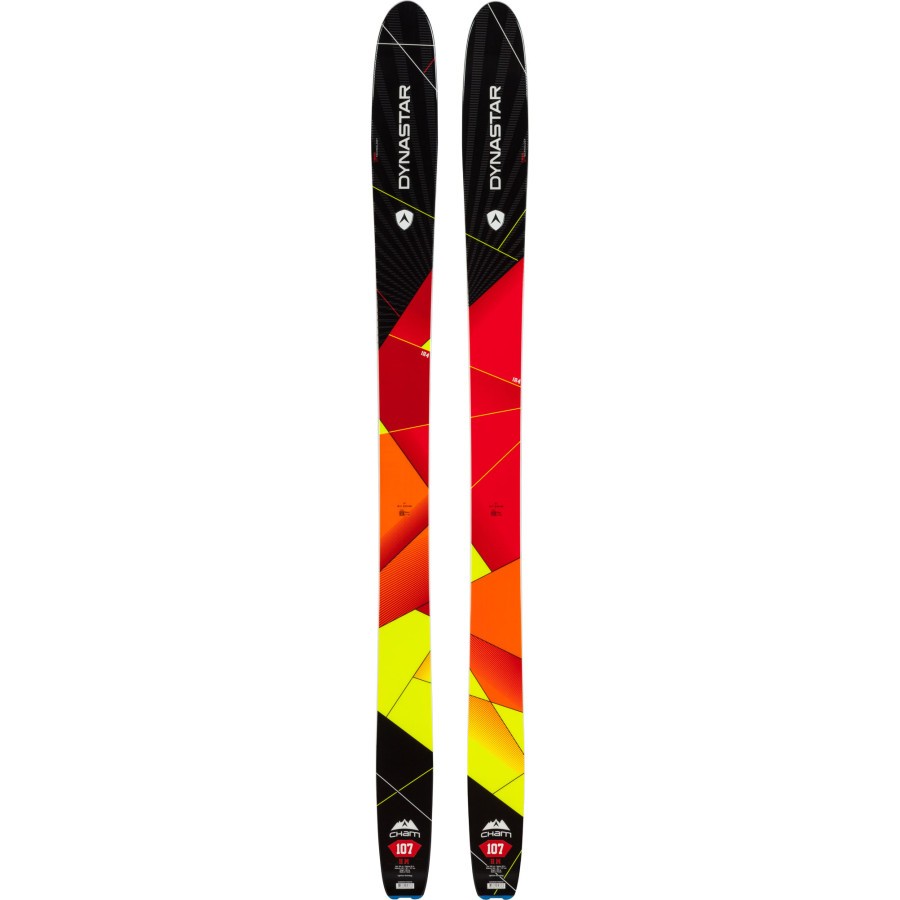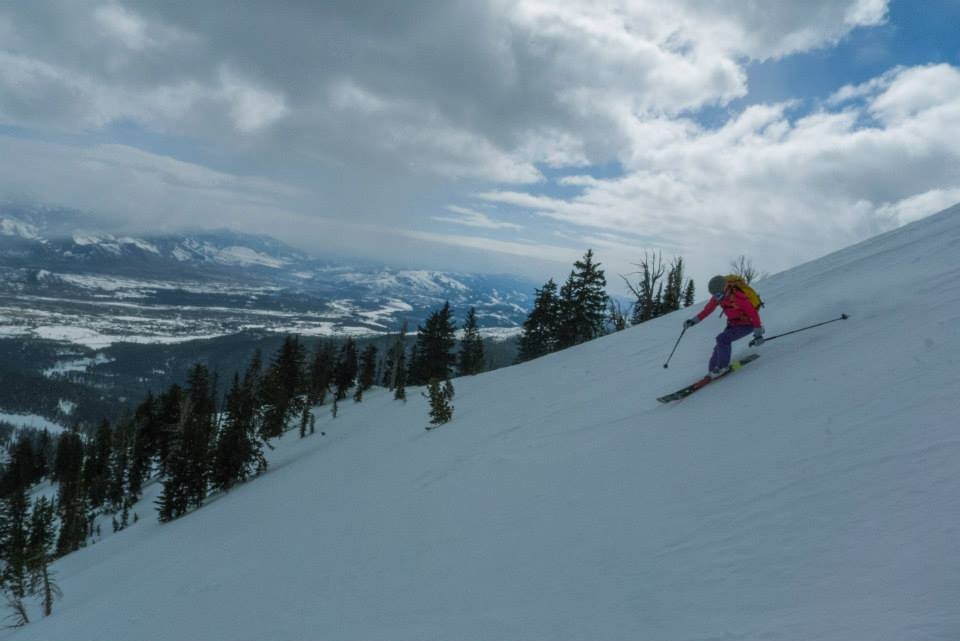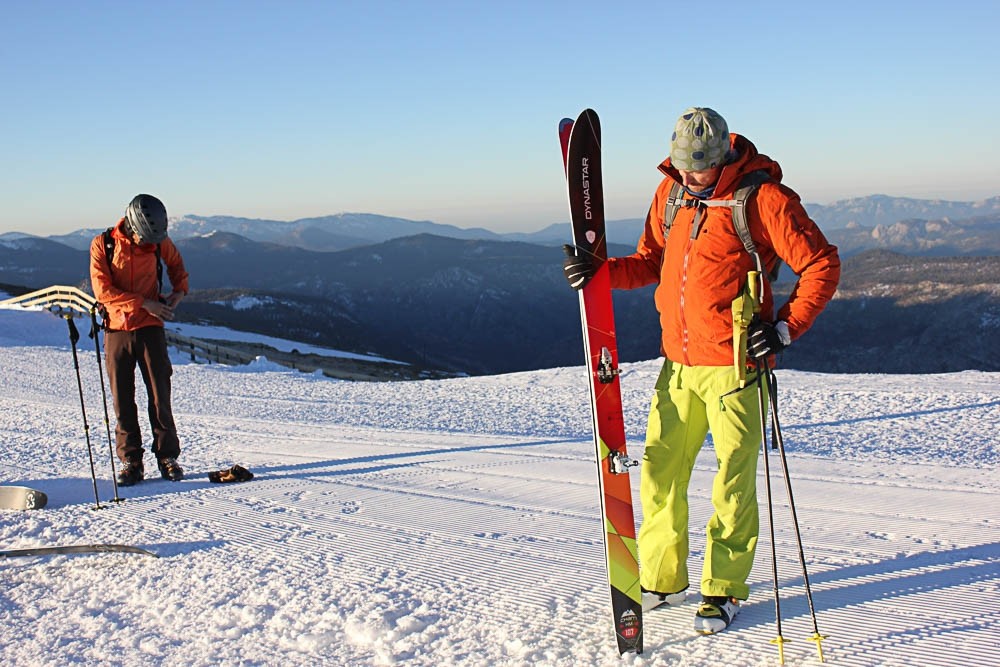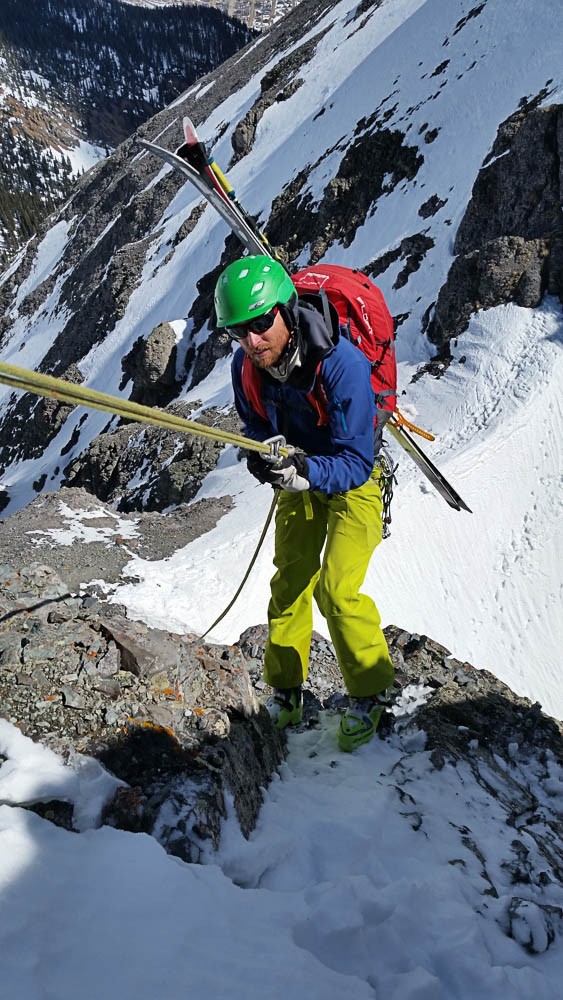Dynastar Cham High Mountain 107 Review
Our Verdict
Our Analysis and Test Results
The Dynastar Cham is the heaviest, best-riding ski in our review. This combination of attributes is not a surprise. With mass comes greater momentum and power, as well as more, and more solid, materials.
Performance Comparison
Weight
The Dynastar is not a ski for the weight conscious. In fact, its mass puts it into the lower reaches of our All Mountain Ski Review and well on the top of this backcountry ski review. It is heavier than the next heaviest ski we reviewed, the Voile V6, by more than a pound. The Cham weighs 160% of what the lightest ski we tested, the La Sportiva Vapor Nano, does.
Versatility
Aside from the weight, this is the most versatile ski we used. In all kinds of downhill conditions, from steep, firm, and narrow, to soft, fast, and open, the Dynastar was consistently a favorite. The Chamonix, France roots of Dynastar, combined with a modern freeride bent, make the Dynastar equally at home in tight, squiggly turns as it is opened up. Poor snow, good snow, hard, or soft, the Dynastar rewards expert skiing technique with a performance that feels like an extension of the rider's legs. For our most accomplished testers, the extra mass of the Dynastar was well worth the additional downhill performance. These same skiers, however, are known to own quivers of skis. They have shorter, lighter, narrower skis for the steep and strenuous tours. That is the one mark against the versatility of the Dynastar. It cannot be overlooked that modern competitors are offering almost-as-good downhill performance at a fraction of the weight. This caveat is the primary reason we chose the Dynastar as a Top Pick instead of our Editors' Choice. Indeed, it goes downhill better than all the others but it is way heavier on the uphill.
Stability
By this point, it could go without saying that the Cham is a stable ski. The length, girth, mass, and construction combine to make a ride that will charge through all kinds of high energy skiing. Whether open and fast or steep and dynamic, the Cham is a ride that keeps up with the best skiers in the most trying of circumstances.
Firm Snow Performance
Generally, with the lighter skis we tested, narrower was better in firm snow. Narrower skis exert less leverage on the edges and are easier to make torsionally stiff. The High Mountain 107 is the exception. It is the second widest ski we reviewed, but one of the better firm snow performers. Only the narrow, carbon infused Fischer Hannibal 94 inspired the same confidence on hard snow. The Dynastar accomplishes this with bulk, stiffness, and moderate side cut. On a rock hard descent of the mega classic Aemmer Couloir on Mount Temple outside Lake Louise, our lead test editor found the Cham 107 to dig like mad. The bigger form factor was more difficult to jump around when necessary, but with a reliable smear and solid platform, the jump was required less often than on smaller, flimsier rides.
Powder Performance
Dang, powder skiing is fun. Just remembering our days of testing and seeking out the soft and fluffy elicits a visceral, giddy feeling. Every modern ski we have ever used is fun in powder. It is entirely possible that powder skiing itself is so fun as to be an absolute distraction from any sort of differences in ski performance from one model to the next. In our testing, every single ski we tested brought great joy to the rider in powder snow. Only a couple of data points stand out from the mileage. The Voile V6 was the liveliest powder ski we tested. It would plunge smoothly at the bottom of every turn, but pop up energetically whenever required. Also, the Dynastar was the most controllable in deep powder. All the other products we tested had what seemed to be a pre-determined powder turn radius. There was a speed and turn frequency seemingly built in. Not so with the Cham 107. The Dynastar plus any accomplished skier were equally comfortable with the quick and squiggly as they were in the fast and long. This performance distinguished the Dynastar from the pack when it comes to powder riding.
Poor Snow Performance
Only two skis in our test received scores of 10 out of 10 for poor snow performance. And this is the only category in which we awarded perfect scores at all. Finally, this is the only category in which our tested products demonstrated a 5-point spread. Poor snow performance is very important to us. Virtually all backcountry ski tours involve poor snow. Whether it is breakable crust or sloppy mashed potatoes, tough stuff is a reality. Good skis can make this tough stuff fun, while most skis require resorting to survival turns at least some of the time. When we say "survival skiing" we mean snowplow turns, wedge christie turns, and even downhill kick turns. Most of our skis in most of the poor conditions we found could be made to do parallel turns in the funk. But two skis turned that difficult snow into fun. The Dynastar and G3 Synapse Carbon 109 fully masked almost any poor snow conditions. Either one of these skis, on the feet of accomplished backcountry skiers, could make high energy, dynamic parallel turns in even the grabbiest breakable or the heaviest slop.
Durability
We had no problems with the durability of the Cham we tested. As the heaviest ski in the test, and manufactured with a full sandwich construction, we anticipate incredible durability. While we did not test them head-to-head with the resort all-mountain skis, we anticipate that the Cham 107 would hold up in that comparison as well. These are beefy rides.
Best Applications
The Cham is not what most of us would pick for our quiver-of-one backcountry touring ski. It is simply too heavy when compared to its contemporaries. However, for super-fit skiers who demand high level downhill performance of their equipment, it could be their only ski. For those with a light set-up already, this could be a good compliment for shorter days, or for those days that involve some mechanized assist. Finally, depending on your choice of binding (see our Alpine Touring Binding Review for a full breakdown of your options), one could consider the Cham as an in-bounds and out-of-bounds crossover tool.
Value
The Cham's price puts in the middle of the pack, but its perceived durability and downhill versatility set it apart. For a tool that should last many hard charging seasons, you will get your money's worth.
Conclusion
In our review, this is a unique product. It is just light enough to tour on, but skis downhill like a proper in-bounds all-mountain ski. While plenty of skiers, especially those newer to the backcountry, are riding and skinning on skis this big and heavy, proper, lightweight backcountry skis are now well worth the compromises they make. Any of the lighter skis in our review are excellent skis that are also super light. It is indeed intimidating to go from beefy resort gear to the tricky conditions of the backcountry on seemingly flimsy, unfamiliar equipment. Trust us, expert skiers easily adjust to the downhill performance and everyone appreciates the lighter weight for touring up. We do know, however, that many people are unwilling to compromise on their downhill performance and are therefore willing to cart around the big guns. For those people, or for those that may have space for a ski like that in their quiver, the Dynastar pushes the compromise further toward downhill performance.
Other Versions and Accessories
Dynastar used to make a ski called the Cham 107. This ski had similar dimensions, but a full metal layer added even more mass. In our all-mountain ski review, we tested the Dynastar Powertrack 89, and it got favorable marks.










